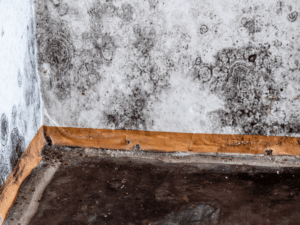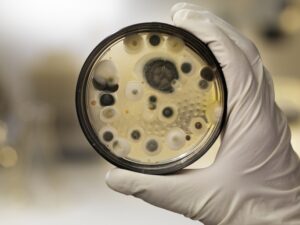What is Black Mold?
Does your home have mold? Even if you’re not aware of it, there’s probably mold somewhere in your house. Mold is parasitic, microscopic fungi that are very common in buildings and homes, and especially grows in moist areas or on paper, cardboard, or wood products. Because it’s got spores that float in the air like pollen, it spreads easily.
Why does this matter? According to a 2004 study by the Institute of Medicine, indoor mold exposure is linked to upper respiratory tract symptoms, coughing, and wheezing in healthy people. In people with asthma, mold exposure triggers asthma symptoms, and the immune-mediated condition hypersensitivity pneumonitis is triggered in people who are susceptible to it. For people who are exposed to large amounts of molds, particularly in occupational settings, severe reactions may occur, including fever and shortness of breath.
What’s more, according to other recent studies, there may be a link between early mold exposure and the development of asthma in children. Removing mold from the house can reduce the incidence of asthma and respiratory allergies. Links between other health effects and mold have been suggested but need more study and are currently unproven. Memory loss, lethargy, and acute idiopathic pulmonary hemorrhage in infants are all thought to be somehow linked to certain molds, including the mold known as Stachybotrys chartarum. It’s difficult to determine when or where a mold exposure has taken place or to definitively connect mold exposure with certain ailments because there’s no blood test or other clinically proven test for mold.
What we do know is the types of people who are most sensitive to molds. People with immune suppression, for instance, are at an increased risk for infection from molds. Additionally, those with underlying lung disease are more likely to contract fungal infections, and those with chronic respiratory disease may experience difficulty breathing. In a family where these conditions exist, it’s especially important to make sure the house is free of mold.

Are certain types of mold worse than others? You’ve probably heard of “toxic molds” or “black molds” that cause serious health hazards when they invade buildings. These molds are toxigenic, which means they produce mycotoxins. Stachybotrys chartarum, a greenish-black mold, is an example of toxigenic mold. It grows on material that contains cellulose, like paper, cardboard, fiberboard, and gypsum board. Because it requires constant moisture to grow, it flourishes when there is moisture in an area, whether from water damage, water leaks, condensation, infiltration, or flooding. Stachybotrys chartarum certainly causes health issues, some of them nonspecific. However, mold is detrimental to your health whether or not it has mycotoxins. Mold comes in a wide range of colors, and its color doesn’t give an indication that one mold is any more dangerous than another. All molds are undesirable and should be removed from your home.
Removing mold from your home, however, can be difficult. Mold is invasive and extremely fast-growing, which makes it hard to eradicate from your home. What’s more, it’s easy for mold to get into your home. It can come in through open doorways, windows, vents, and heating or air conditioning systems. It can also come inside on clothing, shoes, and pets because mold spores float through the air outside. The most common indoor molds are Cladosporium, Penicillium, and Aspergillus, but there’s no clear information about the prevalence of different molds in buildings. Once those spores enter your home, they can drop into spots where there is excess moisture and begin to grow. Any place where there’s a leak, whether it’s your roof, pipes, or walls, or if there’s been flooding somewhere in your home, mold can grow. In fact, mold can even grow in plant pots where the soil is excessively moist. It’s particularly likely to grow in wet paper or wood products, as well as dust, paints, wallpaper, insulation, drywall, carpet, or upholstery.

The best way to handle mold is to keep it from getting a foothold in your home. Minimize your risk of mold spreading through your house by controlling humidity levels, fixing leaks, and not having too many houseplants. Ventilate your crawlspace properly, and have your basement waterproofed to prevent flooding. If you do have flooding in any part of your home, thoroughly clean and dry the area afterward, removing and replacing any items that have been contaminated with mold. Ventilate shower, cooking, and laundry areas, and consider flooring other than carpeting in rooms where moisture can be excessive, like bathrooms or basements. Be aware of the signs of mold, which include spots on surfaces or a musty smell.
If you think you have a mold problem, your best course of action is to call in the professionals. DIY methods of mold removal are rarely effective, and if mold is not removed completely, it will regrow. What’s more, when you try to handle your mold problem yourself, you’re unnecessarily exposing yourself to mold and its accompanying health issues. Need more reasons to hire a professional mold remediation company? We’ve got three for you:
- Professionals know how to thoroughly remove mold. It’s extremely difficult to completely eradicate mold, and homeowners often find themselves battling the same infestation over and over. Using professional tools and products, mold remediation experts can completely rid your home of mold.
- It’s safer to hire an expert to handle the job. The health impact of mold exposure can range from allergic reactions and respiratory infections to much more serious health problems. In fact, mold exposure is sometimes fatal. Professionals have the knowledge and safety equipment to remove mold from your home without exposing your family to any health risks.
- Mold remediation experts can prevent future infestation. A professional team can identify risk factors and problem areas that allow mold into your home. In addition to removing mold, experts can recommend services and practices to prevent future mold problems. Basement waterproofing, foundation repair, roof repair, and installing additional ventilation are all steps sometimes required to keep mold from coming back.
Whether you need mold remediation or another basement-related service, Budget Waterproofing has got you covered. At Budget Waterproofing, we’ve got more than 55 years of experience servicing both commercial and residential customers throughout Maryland. We’re proud of our craftsmanship and confident in our skills, and all of our technicians are fully licensed and insured. Whether you need basement waterproofing, a drainage system, crawl space waterproofing, or egress window installation, we’ve got you covered, with the experience and skills necessary to improve your basement and protect your family. For more information, contact us today.
